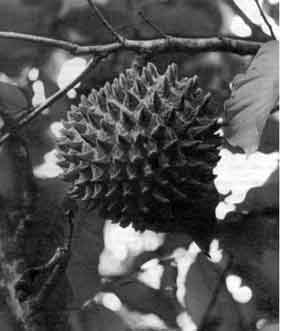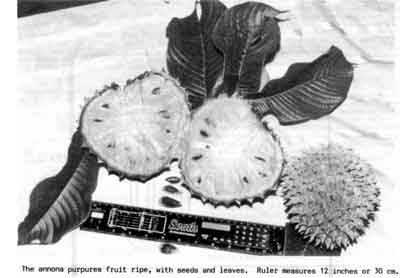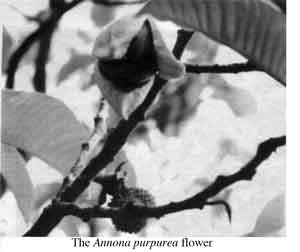
SONCOYA
SCIENTIFIC NAME: Annona purpurea
FAMILY: Annonaceae
 Don and I have collected many annonaceous fruits over the years and one type which has been quite different to all the others is the Annona purpurea or SONCOYA.
Don and I have collected many annonaceous fruits over the years and one type which has been quite different to all the others is the Annona purpurea or SONCOYA.
The main thing which differs it from other annonaceous fruits is the spiky hard skin, somewhat resembling a durian, which terminates in short hooks curved towards the stem, and is very aromatic when ripening. It is hard to know when to pick the Soncoya as the skin does not change colour. The skin or hard spiky shell is browny-green, from small fruit to maturity. We have found the ripe fruit on the ground in the mornings, the fruit having a hole where the stem was attached. At this stage the fruit is still intact and the fruit's keeping qualities are not deteriorated. It will keep in the fridge for two weeks.
Slicing it in half with a knife, the skin was quite easy to cut through. The flesh is a bright orange with quite a number of 2½-cm-long seeds, the flesh sticking to the seeds. The Soncoya has a pleasant peachy/apricot/pawpaw flavour, but is of a quite fibrous texture. The Soncoya also reminds us of a South American Sapote or Matisia.
I scooped out the fruit and gave it the soursop treatment by pushing the flesh through a colander. The juice or cream was a little sticky but very pleasant. Don mixed it with some custard apple flesh and froze it before I could get anyone else to taste it for comments.

Talking about the tree ... Don does not remember where he got it originally but it must have been a piece of scion wood and he grafted it onto a soursop seedling.
The tree is now 16 years old and about 15 feet or four to five metres high. It is quite an open tree. Don has not pruned it. It could respond to pruning in winter like custard apples to encourage new growth and more flowers. This yea, 1995, the Soncoya had about 15 flowers in February. The flowers resemble that of the soursop but are larger with a red/orange centre bauble. February is when I photographed the flowers but it must have flowered earlier as in the photo there is a small fruit.
I just went and inspected the tree and got stung by a bee. Perhaps it should not be pruned. I had a close look and on many new branches about 2 to 4 leaves back from the tip there are little round, hard objects, perhaps new flowers. I will have to observe further to see if these develop into flowers. It is now May 27th, 1995.

The Annona purpurea's leaves are big and papery, measuring 30 cm from tip to stem and 15 cm wide. The backs of the leaves are covered in distinct yellow/brown veins, much like the fine rib bones of a fish.
On each small branch six to eight leaves grow, but are not opposite each other. The bark is grey/brown and quite bumpy.
Popenoe records the Annona purpurea as originating from Southern Mexico and Central America. He says it is sold in local markets and suggests that the Soncoya has the possibilities for annona breeding. How about an orange flesh custard apple or soursop cross? It would have a delightful flavour and colour.
We look after the Soncoya much as we look after all the trees - watered at flowering and given very little fertilizer. We no longer can get filter mud, so Don is now using sand as a mulch. Very successful - but that's another story.
DATE: July 1995
* * * * * * * * * * * * *
